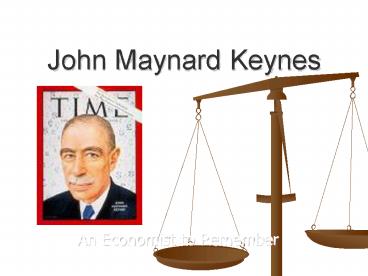John Maynard Keynes - PowerPoint PPT Presentation
1 / 11
Title: John Maynard Keynes
1
John Maynard Keynes
- An Economist to Remember
2
Who Was JM Keynes?
- Born in Cambridge to an economics professor and
an accomplished author - Married russian ballerina Lydia Lopokova in
October 1925 - Attended Eton and Kings College, earned his B.A.
in 1905 and his M.A. in 1909 - Described by acquaintances as highly intelligent
and very articulate
3
Who/ What Influenced JM Keynes?
- His father, John Neville Keynes, an economics
lecturer at Cambridge - Arthur Pigou, Alfred Marshall, Adam Smith, Karl
Marx, and Thomas Malthus - The unfair treatment of the Germans in the Treaty
of Versailles - The Great Depression of the 1930s in America
4
Becoming Known to the Public
- Accepted lectureship at Cambridge
- Later appointed to the Royal Commission on Indian
Currency and Finance - Worked as advisor during WWI designing terms of
credit between allies and acquiring rare
currencies. Robert Lekachmen said at this point
Keynes nerve and mastery became legendary.
5
Becoming Known to the Public
- Wrote The Economic Consequences of the Peace,
voicing disapproval with the treaty of Versailles - Keynes wrote General Theory of Employment,
Interest and Money. His revolutionary ideas
reshaped economic theory, creating Keynesian
Economics.
6
Keynesian Economics How It Is Different From
Classical Economics
- GDP the sum of consumption, investment,
government spending, and net export - Enhance employment by first increasing
expenditures
- Total Savings of Society is determined by the
total income - Government necessity to stimulate demand in times
of high unemployment
7
Gross Domestic Product
- The sum of consumption, investment, net exports,
and government spending. - Government could and should take an active role
in stabilizing the economy by increasing
government spending (stimulus) in times of high
unemployment and decreasing spending in times of
economic security.
8
Increasing Expenditures to Enhance Employment
- Stimulating economic growth via government
spending (i.e. public works projects, defense
spending, entitlement programs) increases demand
for workers. - The government has two levers on the economy
government spending and taxation. Using these
two tools the government can keep the economy
more balanced.
9
Total Savings
- Savings was considered bad for the economy
because it reduced spending. - Keynes proved that (because of banks) savings
become money that is actively spent through loans
etc so having that surplus actually helps
stimulate the economy. - The total savings of a society GDP because saved
money is loaned and spent.
10
Keynes Legacy
- Died on April 21, 1946
- Raised to the House of Lords as Baron Keynes in
1942 - A subfield of macroeconomics (Keynesian
economics) was created from his work and
revolutionary ideas - Countless economists have since redefined their
understanding of economics because of Keynes
theories
11
Bibliography
- John Maynard Keynes. www.wikipedia.org, last
modified January 15, 2007. - The biography of John Maynard Keynes.
www.econlib.org, David R. Henderson - Google image vault. www.google.com
- Image source The Print Shop 12

